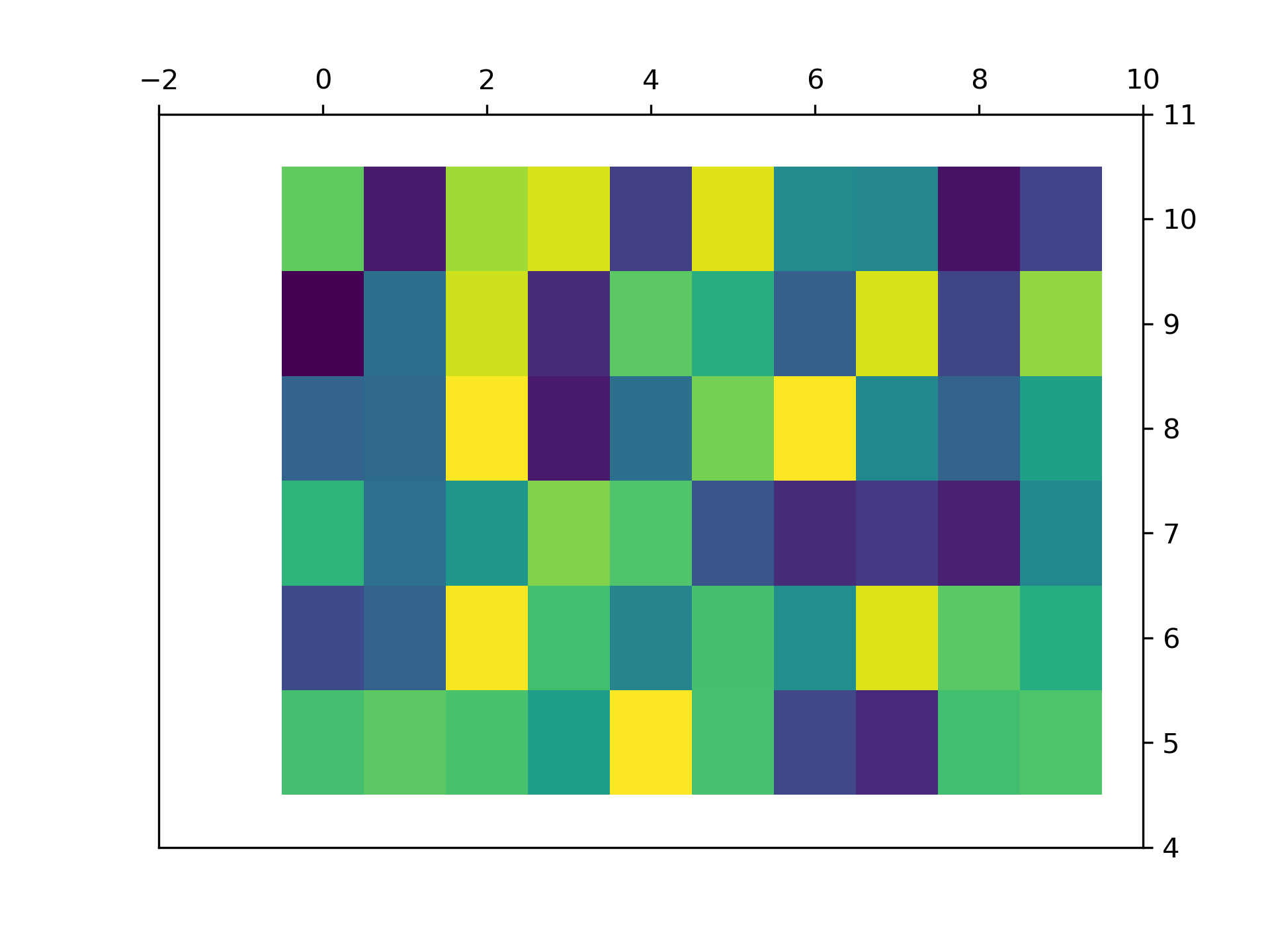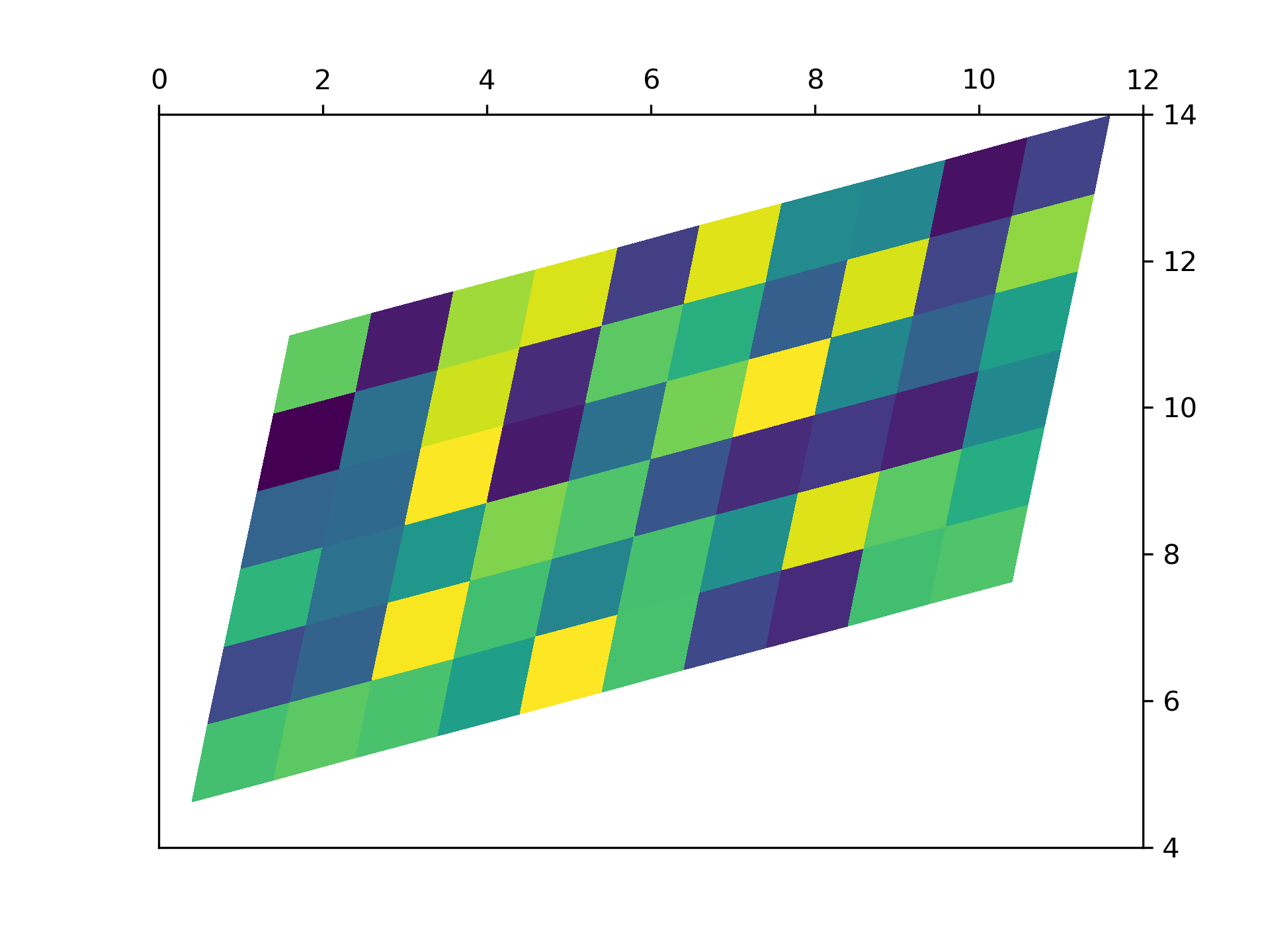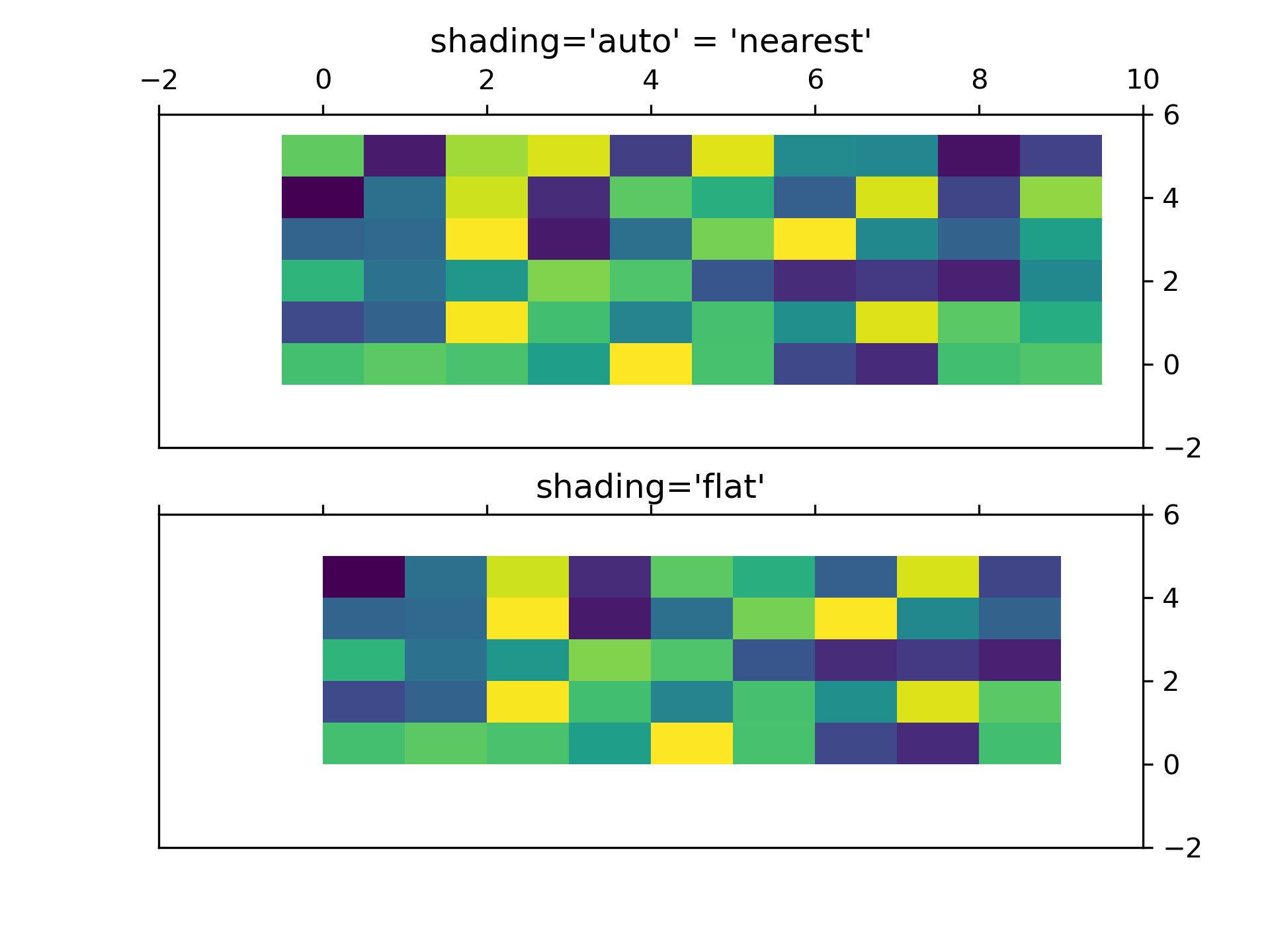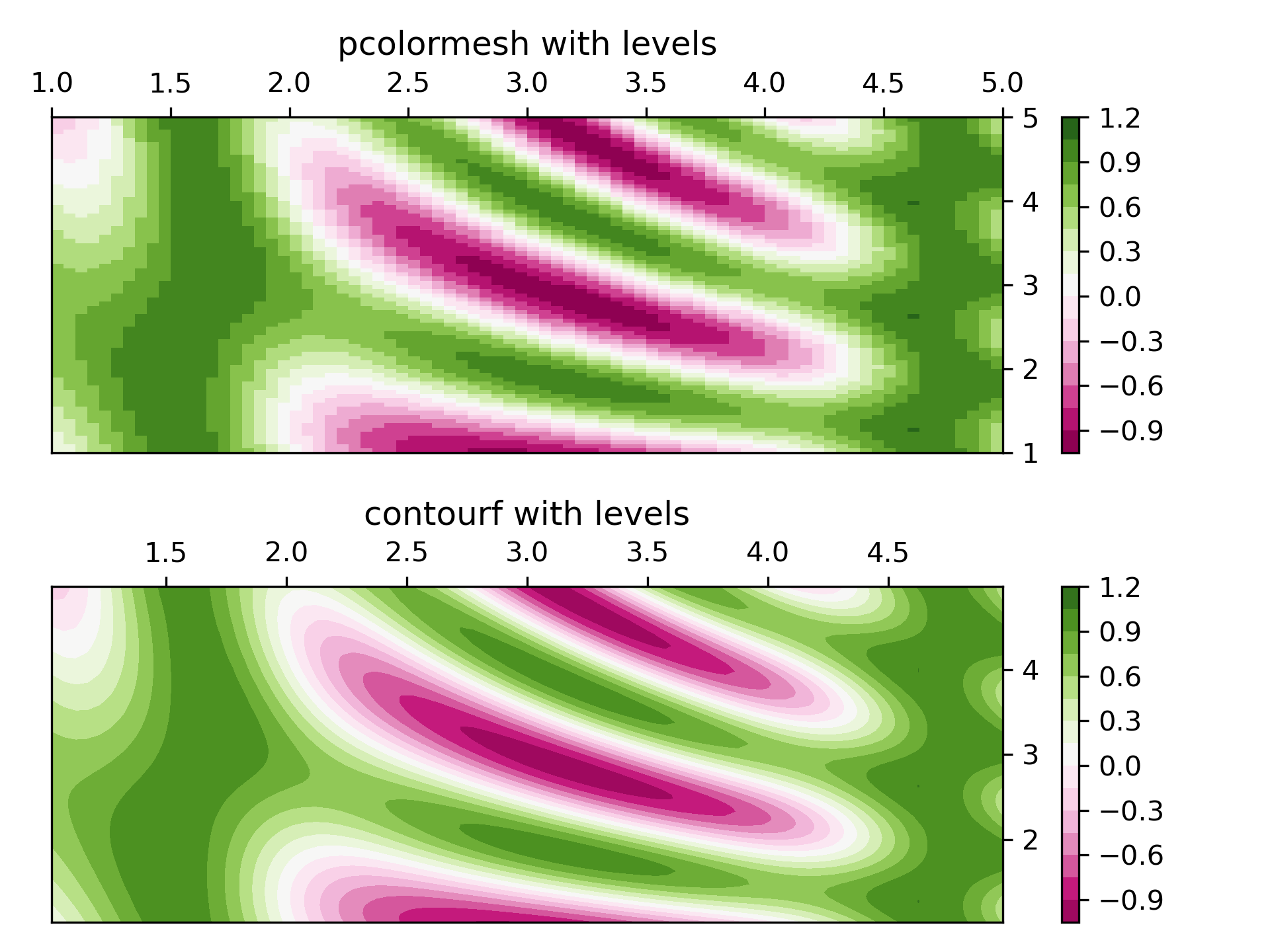>>> """
==========
pcolormesh
==========
`.axes.Axes.pcolormesh` allows you to generate 2D image-style plots. Note it
is faster than the similar `~.axes.Axes.pcolor`.
"""
...
... import matplotlib.pyplot as plt
... from matplotlib.colors import BoundaryNorm
... from matplotlib.ticker import MaxNLocator
... import numpy as np
...
... ###############################################################################
... # Basic pcolormesh
... # ----------------
... #
... # We usually specify a pcolormesh by defining the edge of quadrilaterals and
... # the value of the quadrilateral. Note that here *x* and *y* each have one
... # extra element than Z in the respective dimension.
...
... np.random.seed(19680801)
... Z = np.random.rand(6, 10)
... x = np.arange(-0.5, 10, 1) # len = 11
... y = np.arange(4.5, 11, 1) # len = 7
...
... fig, ax = plt.subplots()
... ax.pcolormesh(x, y, Z)
...
... ###############################################################################
... # Non-rectilinear pcolormesh
... # --------------------------
... #
... # Note that we can also specify matrices for *X* and *Y* and have
... # non-rectilinear quadrilaterals.
...
... x = np.arange(-0.5, 10, 1) # len = 11
... y = np.arange(4.5, 11, 1) # len = 7
... X, Y = np.meshgrid(x, y)
... X = X + 0.2 * Y # tilt the coordinates.
... Y = Y + 0.3 * X
...
... fig, ax = plt.subplots()
... ax.pcolormesh(X, Y, Z)
...
... ###############################################################################
... # Centered Coordinates
... # ---------------------
... #
... # Often a user wants to pass *X* and *Y* with the same sizes as *Z* to
... # `.axes.Axes.pcolormesh`. This is also allowed if ``shading='auto'`` is
... # passed (default set by :rc:`pcolor.shading`). Pre Matplotlib 3.3,
... # ``shading='flat'`` would drop the last column and row of *Z*; while that
... # is still allowed for back compatibility purposes, a DeprecationWarning is
... # raised. If this is really what you want, then simply drop the last row and
... # column of Z manually:
...
... x = np.arange(10) # len = 10
... y = np.arange(6) # len = 6
... X, Y = np.meshgrid(x, y)
...
... fig, axs = plt.subplots(2, 1, sharex=True, sharey=True)
... axs[0].pcolormesh(X, Y, Z, vmin=np.min(Z), vmax=np.max(Z), shading='auto')
... axs[0].set_title("shading='auto' = 'nearest'")
... axs[1].pcolormesh(X, Y, Z[:-1, :-1], vmin=np.min(Z), vmax=np.max(Z),
... shading='flat')
... axs[1].set_title("shading='flat'")
...
... ###############################################################################
... # Making levels using Norms
... # -------------------------
... #
... # Shows how to combine Normalization and Colormap instances to draw
... # "levels" in `.axes.Axes.pcolor`, `.axes.Axes.pcolormesh`
... # and `.axes.Axes.imshow` type plots in a similar
... # way to the levels keyword argument to contour/contourf.
...
... # make these smaller to increase the resolution
... dx, dy = 0.05, 0.05
...
... # generate 2 2d grids for the x & y bounds
... y, x = np.mgrid[slice(1, 5 + dy, dy),
... slice(1, 5 + dx, dx)]
...
... z = np.sin(x)**10 + np.cos(10 + y*x) * np.cos(x)
...
... # x and y are bounds, so z should be the value *inside* those bounds.
... # Therefore, remove the last value from the z array.
... z = z[:-1, :-1]
... levels = MaxNLocator(nbins=15).tick_values(z.min(), z.max())
...
...
... # pick the desired colormap, sensible levels, and define a normalization
... # instance which takes data values and translates those into levels.
... cmap = plt.colormaps['PiYG']
... norm = BoundaryNorm(levels, ncolors=cmap.N, clip=True)
...
... fig, (ax0, ax1) = plt.subplots(nrows=2)
...
... im = ax0.pcolormesh(x, y, z, cmap=cmap, norm=norm)
... fig.colorbar(im, ax=ax0)
... ax0.set_title('pcolormesh with levels')
...
...
... # contours are *point* based plots, so convert our bound into point
... # centers
... cf = ax1.contourf(x[:-1, :-1] + dx/2.,
... y[:-1, :-1] + dy/2., z, levels=levels,
... cmap=cmap)
... fig.colorbar(cf, ax=ax1)
... ax1.set_title('contourf with levels')
...
... # adjust spacing between subplots so `ax1` title and `ax0` tick labels
... # don't overlap
... fig.tight_layout()
...
... plt.show()
...
... #############################################################################
... #
... # .. admonition:: References
... #
... # The use of the following functions, methods, classes and modules is shown
... # in this example:
... #
... # - `matplotlib.axes.Axes.pcolormesh` / `matplotlib.pyplot.pcolormesh`
... # - `matplotlib.axes.Axes.contourf` / `matplotlib.pyplot.contourf`
... # - `matplotlib.figure.Figure.colorbar` / `matplotlib.pyplot.colorbar`
... # - `matplotlib.colors.BoundaryNorm`
... # - `matplotlib.ticker.MaxNLocator`
...







